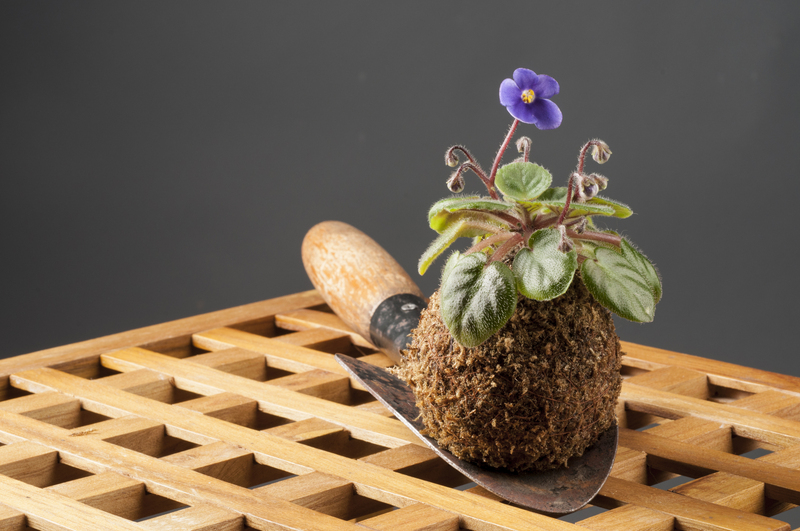Gardening for Mindfulness: Build a Zen Retreat Outdoors
Posted on 30/06/2025
Gardening for Mindfulness: Build a Zen Retreat Outdoors
Stress and hurry have become constants in modern life, but your outdoor space can transform into an oasis for tranquility and self-care. Gardening for mindfulness is not just a trend--it's an invitation to reconnect with nature, ground yourself in the present moment, and nurture your inner peace. Imagine stepping outside into a Zen-inspired garden retreat, where every corner radiates calm and clarity.
In this comprehensive guide, we'll explore:
- What is mindful gardening?
- Why build a Zen retreat outdoors?
- Key elements of a mindfulness garden
- Step-by-step instructions to create your own Zen sanctuary
- Plants and features ideal for a peaceful retreat
- Mindful gardening tips for beginners and enthusiasts
- Maintaining mindfulness as your garden grows
Why Choose Gardening for Mindfulness?
Gardening has been shown to reduce stress levels, enhance mood, and foster a sense of achievement. Mindfulness--the practice of paying attention to the present moment without judgement--can be easily woven into gardening tasks for profound benefits:
- Reduced anxiety and depression
- Lowered levels of cortisol (the stress hormone)
- Deeper connection with nature and yourself
- Enhanced creativity and mental clarity
- Improved physical health through gentle outdoor activity
Gardening for mindfulness doesn't require expert skills. Anyone--from suburban homeowners to balcony-dwellers--can adopt this approach and create a calming garden retreat that soothes the mind and refreshes the spirit.

What Is a Zen Garden?
Zen gardens, originating in Japanese Buddhist traditions, are designed to inspire meditation, tranquility, and simplicity. They are known for:
- Minimalist design
- Natural materials like stone, sand, gravel, and wood
- Symbolic plantings and intentional empty spaces
- Elements that encourage reflection and mindfulness
The philosophy behind Zen landscaping is to clear away excess and focus on balance, symmetry, and sensory experience. This philosophy makes it the perfect style for a mindful outdoor retreat.
Main Elements of a Mindfulness Garden Retreat
To build a Zen retreat outdoors, it's important to consider both the design and the atmosphere you want to foster. Below are the most essential ingredients for your outdoor mindfulness garden:
1. Simple, Open Spaces
Embrace uncluttered layouts that allow the eyes--and the mind--to rest. Avoid overcrowding with too many plants or decorations.
2. Natural Materials
- Use stone, gravel, sand, and wood for pathways and seating.
- Choose organic shapes and textures to mirror the beauty of nature.
3. Flowing Water
The sound of running water adds a calming, meditative quality. Install a simple fountain, bubbling rock, or a small pond if possible.
4. Mindful Planting
- Prioritize evergreens and low-maintenance plants.
- Select species with soothing colors and pleasing scents.
5. Symbolic Accents
- Add lanterns, rocks, or statues to encourage reflection.
- Incorporate elements that hold personal meaning or tell a story.
6. Spaces for Sitting and Meditation
Dedicate a quiet spot with a bench, cushion, or stepping stones for stillness and contemplation.
Step-by-Step: How to Build a Zen Retreat in Your Garden
Ready to begin? Creating an outdoor Zen retreat is achievable for gardens of all shapes and sizes. Here's a detailed process to help you transform your space for maximum tranquility.
Step 1: Assess Your Space
- Walk around your garden or balcony. Notice areas that feel calm or secluded--these make ideal locations for a Zen corner.
- Observe sun and shade patterns. Take note of existing plants and features you can incorporate.
Step 2: Plan a Simple Layout
- Sketch a rough outline, using curved or straight lines for paths and beds.
- Leave open space--empty areas are just as vital in mindful gardening as planted ones.
- Position seating and water features where you'll enjoy them most.
Step 3: Select Calm Plantings
- Evergreen shrubs (like boxwood or bamboo) provide year-round structure.
- Moss, ferns, and hostas offer soft greenery and require minimal care.
- Choose fragrant plants (lavender, jasmine) for sensory relaxation.
- Limit your color palette to greens, whites, and pale hues for a soothing effect.
Step 4: Add Water Elements
- Install a recirculating fountain for gentle white noise.
- Try a bowl of floating water with petals, or a simple clay pot bubbler if space is tight.
Step 5: Place Symbolic Stones and Ornaments
- Arrange rocks to symbolize mountains or islands.
- Use gravel or sand raked into patterns to reflect the flow of water or wind.
- Consider statues or lanterns as focal points for meditation.
Step 6: Create Pathways
- Place stepping stones or gravel paths to slow your pace and encourage mindful walking.
- Use materials like slate, wood, or natural pebbles for a harmonious look.
Step 7: Design a Meditative Seating Area
- Add a weatherproof bench, wooden deck, or simple stone slab for contemplation.
- Create partial screening with plants or a bamboo fence to enhance privacy.
Step 8: Use Lighting Thoughtfully
- Soft solar or LED lights can create a magical mood after sunset.
- Avoid harsh spotlights so the atmosphere remains serene.
Best Plants for Mindful Zen Gardens
Plant selection is crucial when cultivating an outdoor mindfulness retreat. Here are the most recommended options for a tranquil garden:
- Bamboo -- Symbolizes flexibility and strength, ideal for subtle screening.
- Moss -- Invites softness and a timeless, undisturbed look.
- Ferns -- Elegant foliage that thrives in shade and adds textural interest.
- Japanese Maple -- Offers delicate leaves and seasonal color with a sculptural form.
- Camellias -- Bloom even in winter, signifying perseverance and beauty.
- Hostas -- Low-maintenance, lush leaves, perfect for ground cover.
- Nandina -- Also called heavenly bamboo, brings year-round interest.
- Lavender and Jasmine -- Aroma therapeutic benefits, and attract pollinators.
- Cherry Blossom (Sakura) -- If space allows, the ultimate symbol of fleeting beauty and mindfulness.
Tip: Choose native plants where possible--they require less care and nurture local wildlife, reinforcing your connection to the environment.
Incorporating Mindfulness in Gardening Activities
While the design of your Zen garden sets the stage, the real magic comes from practicing mindful gardening rituals. Here are a few ways to make your gardening a meditative practice:
- Prepare the Space with Intention: Take a few deep breaths before you begin, centering your mind on the present moment.
- Savor the Senses: Pay close attention as you work--notice the soil's texture, the fresh scent of leaves, the play of light and shadow.
- Move Slowly and Gently: Approach tasks like raking, watering, or trimming as moving meditations. Focus on the rhythm and sensation of each activity.
- Observe Without Judgement: If weeds grow or plants fail, see them as a natural part of the cycle, not mistakes. Practice acceptance and patience--qualities at the heart of mindfulness.
- Create Rituals: Try taking tea or a journal into your garden at the same time each day, reflecting on nature's quiet changes and your own moods.
Tips for Maintaining Your Zen Retreat
A mindful garden retreat is not just a one-time project--it's an evolving haven that asks for regular attention and care. Here's how to keep it serene and inviting year-round:
- Weed lightly and regularly, but allow some natural growth to encourage wildlife and a wild, unforced beauty.
- Prune with mindfulness--enjoy the subtle changes you bring with each trim.
- Refresh water features and clean pathways routinely to maintain calm energy.
- Revisit your favorite seating area often, even if just for a few minutes.
- Rotate seasonal accents--like new lanterns or fresh-cut flowers--to keep the space engaging.

Benefits of Outdoor Mindfulness and a Zen-Inspired Retreat
Those who adopt gardening for mindfulness practices consistently report noticeable improvements in their mental, emotional, and physical wellbeing. Some of the wide-ranging benefits include:
- Lowered stress and higher resilience
- Better sleep and enhanced mood
- Greater focus and less distracted thinking
- Deeper appreciation for the present moment
- Opportunities for gentle movement and vitamin D exposure
Beyond these personal rewards, a Zen retreat garden also provides refuge for pollinators, birds, and beneficial insects, supporting the ecosystem around you.
Final Thoughts: Begin Your Mindful Gardening Journey Today
Building a Zen retreat outdoors is one of the most rewarding ways to bring peace, clarity, and joy into your daily life. By combining thoughtful design, natural elements, and simple mindfulness rituals, you can create a haven that nurtures body and soul--no matter the size of your space or your gardening experience.
Let your new outdoor sanctuary be a gentle reminder: every day holds an opportunity to slow down, breathe deeply, and appreciate the beauty of the world around you. Start small or dream big--the path to mindful gardening is always open.
Ready to cultivate calm? With these tips and ideas, you're set to create a gardening for mindfulness retreat that is both beautiful and beneficial for years to come. Begin today and watch as your outdoor Zen sanctuary blossoms into a true retreat for the mind and spirit.



